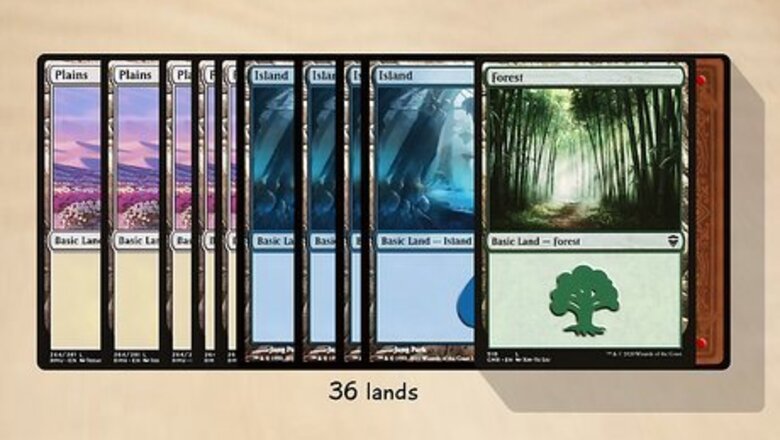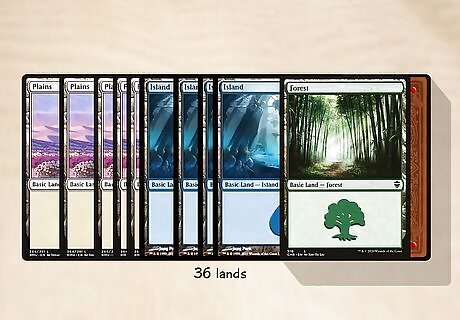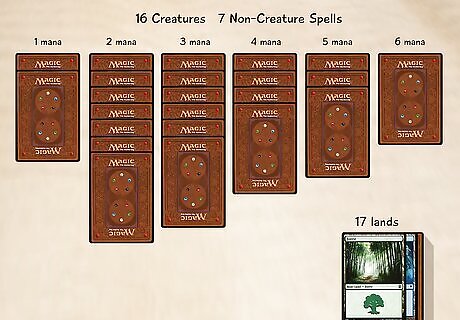
views
- Aim for 36 lands in a Commander deck. You can always increase or decrease the land count from there.
- The more aggressive your deck is and the lower your curve is, the fewer lands you need and vice versa. Ensure that you can consistently cast your commander on curve.
- Add 5-12 mana rocks depending on how deep your deck goes. Every deck should run Sol Ring and Arcane Signet.
How many lands should you have in EDH?

You typically want to use 36 lands as a baseline. Elder Dragon Highlander (EDH) or Commander players generally agree that you want somewhere between 32 and 42 lands in your deck. As a rule of thumb, it’s safe to start at 36 lands and then adjust up or down based on your personal preferences and the curve of your deck. If you’re curious about Commander’s land ratio, 36 lands is the equivalent of 14.5 lands in a 40-card deck and 21.8 lands in a 60-card deck. With 36 lands, you have a 90.6% chance to draw 2 (or more) lands in your first 9 cards. That’s your opening hand of 7, plus two draw steps. Hitting your lands early on is essential. It’s okay if you miss a land drop after you already have an established board, but it can be very painful to miss the first two steps.
What is a mana curve?

The curve refers to the distribution of mana costs in your deck. Picture all of the cards in your deck set out on a table with the 1 converted mana cost (CMC) cards stacked on one another, followed by the 2 CMC cards, 3 CMC cards, etc. Your curve refers to the literal shape of these stacks. Understanding your curve is important—especially as it pertains to the land count. The deeper your curve is, the more lands you likely need. For example, a “low” curve might contain mostly 1- and 2-drops and “top out” at a card with 4 mana. These kinds of decks can usually justify a lower land count. A bigger curve may mostly be 3- and 4- drops and top out at 7- or 8-mana cards. These decks may need more lands. Alternatively, you might construct a deck like this to have fewer lands and more rocks or ramp spells.
How many mana rocks should you run in EDH?
You likely want 5-12 rocks depending on your curve. A mana rock refers to any artifact that generates mana. They’re kind of like lands that you pay mana for, but they’re beneficial because they speed your game plan up to generate more mana early. A faster aggro deck may only need around 5 rocks, while a ramp deck aiming to play big creatures likely wants over 10 rocks. Basically every single Commander deck should run Sol Ring and Arcane Signet. These two are just too cost-efficient to justify cutting them. If you’re running more than 2 colors, include mana rocks that can fix your mana. For example, if you’re running a blue, black, and green deck, you likely want a Dimir Signet and a Golgari Signet.
When to Decrease Your Land Count
You’re playing a deck with a very low mana curve. This is going to apply to most aggro decks—especially if they’re mono-red or mono-white. You may be able to get away with 32-34 lands if you really only need 1-2 lands for your deck to function. This also helps increase the odds that your top-deck draws aren’t dead later in the game. It’s not that low mana curve decks don’t need 3-4 lands in play, it’s just that you can often get away with missing land drops. If your hand is full of 1- and 2-drops, you are going to empty your hand so fast that you’ll likely be able to wait
Your deck contains a lot of mana dorks. Mana dorks refer to any 1- or 2-CMC creature that generates mana. The most iconic dorks are Elvish Mystic, Birds of Paradise, and Noble Hierarch, but there are dozens of playable options. You’ll likely want to trim a few lands if you have a bunch of dorks in your deck.
Your commander helps you fetch lands. There are a lot of popular commanders that either generate mana or help you fetch lands out of your deck. If you’ve got one of these commanders, you can usually get away with cutting a few lands. You’ll make up any deficit you develop on the board when your commander hits the battlefield. Chulane, Teller of Tales is probably the most popular land-fetching commander. Some ramp commanders, like Arixmethes, Slumbering Isle, can replace lands, too!
When to Increase Your Land Count
Your curve is very high. If your deck is full of cards that cost more than 4 CMC, you really can’t afford to miss land drops. It’s likely you want to increase your land count—potentially even up to 42-44 lands—just to ensure that you cast those big haymakers in your deck. Balance the land count increase against the mana rocks you’re running. You may not need to increase your land count by much if you add a bunch of ramp spells and rocks.
You’re running a “lands matter” deck. Do you have a Strip Mine and Crucible combo in your deck? What about a Dark Depths and Thespian's Stage package? If you have a land-focused deck, you’ll likely have a naturally higher land count.
You have a lot of situational utility lands. When you’re looking at lands like Boseiju, Who Endures or Sea Gate Restoration, you’re really looking at spells that could be lands. In most cases, you’ll want to hold on to these cards to use their abilities or cast their spells. If your deck contains a lot of these, you likely want a few more “pure” lands to compensate. Just how many utility lands you include is entirely up to you.
Variables to Consider
You need to be able to cast your commander on curve. The Commander format revolves around the titular commanders, and most players optimize their land count and curve to ensure they can cast the commander on time. Even if your deck has a really low curve, you probably want a sizable land count if you’re running a 4- or 5-mana commander. The classic example is Krenko, Mob Boss. Krenko only slots into goblin aggro decks, but at 4 mana, Krenko is kind of pricey. How many lands do Krenko decks tend to run? Over 36! Krenko is just that important to the game plan.
Ramp spells may or may not justify fewer lands. It’s easy to see how you can kind of treat a card like Sol Ring as a land. One mana turns into three mana for one land. But what about a 3-mana spell like Kodama’s Reach? If your deck runs 5-10 ramp spells, you may want to adjust your land count (up or down, depending on the goal). A deck may want ramp spells and more lands if they have a lot of 7-, 8-, or 9-mana cards. However, a deck may want fewer lands alongside ramp spells if the goal is to get to 4 or 5 mana on turn 3. In MTG, “ramp” refers to anything that speeds up your access to mana.


















Comments
0 comment